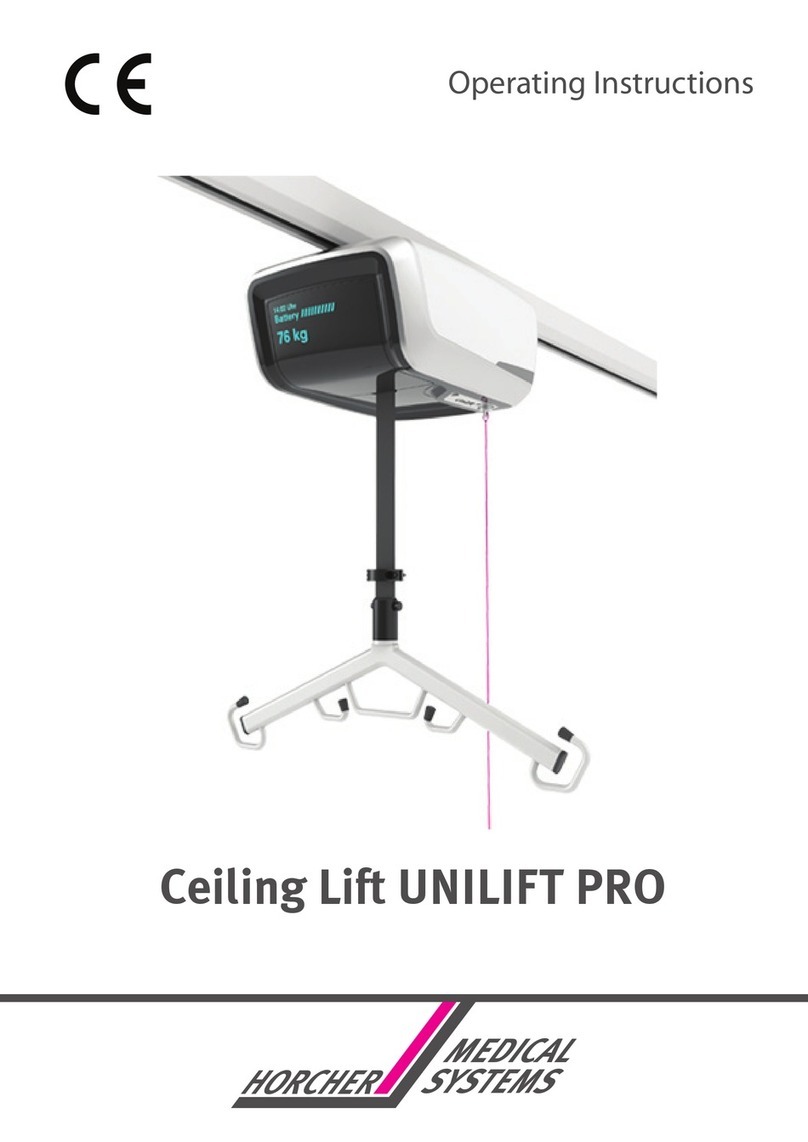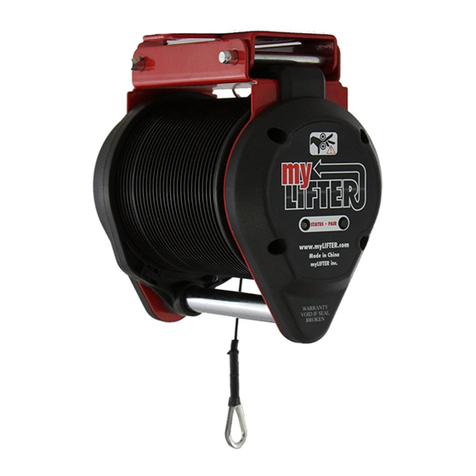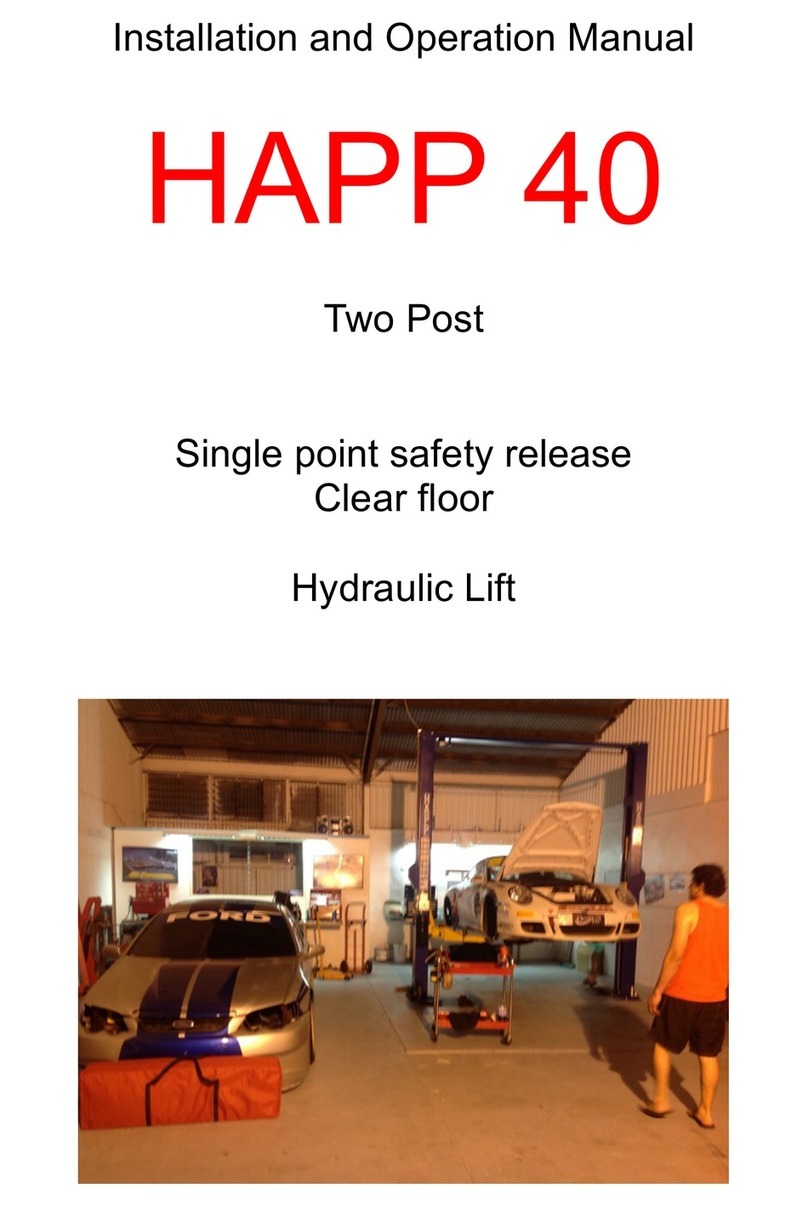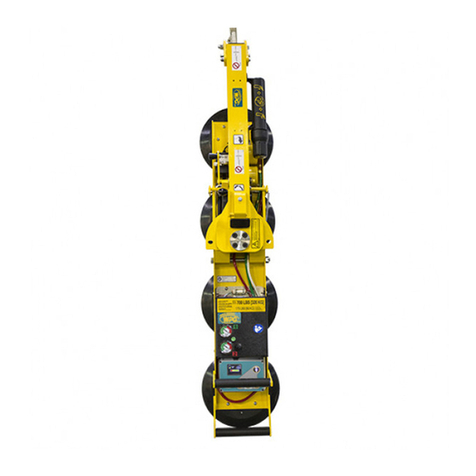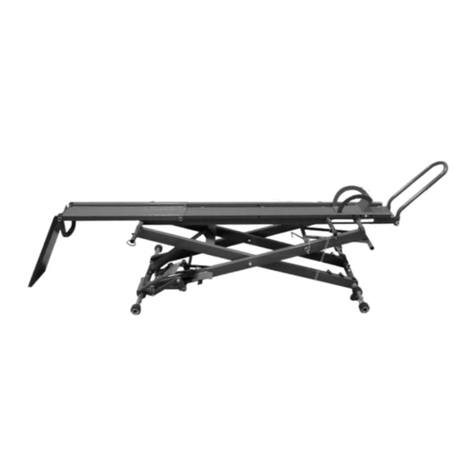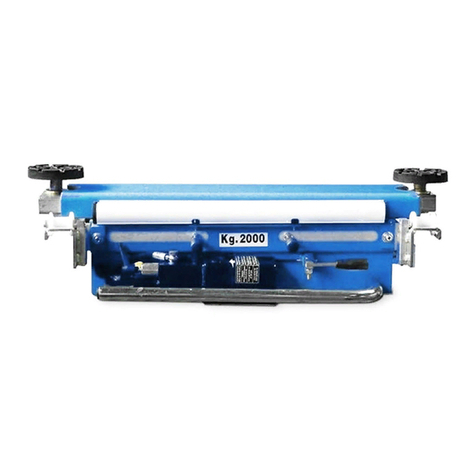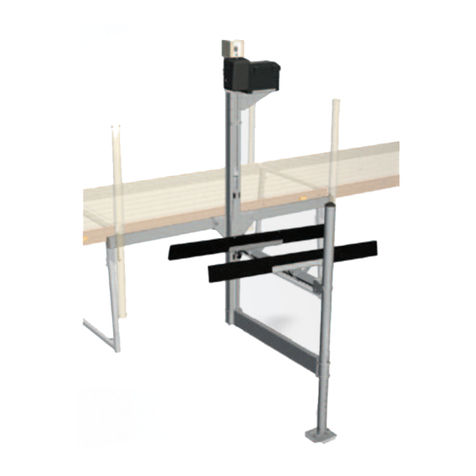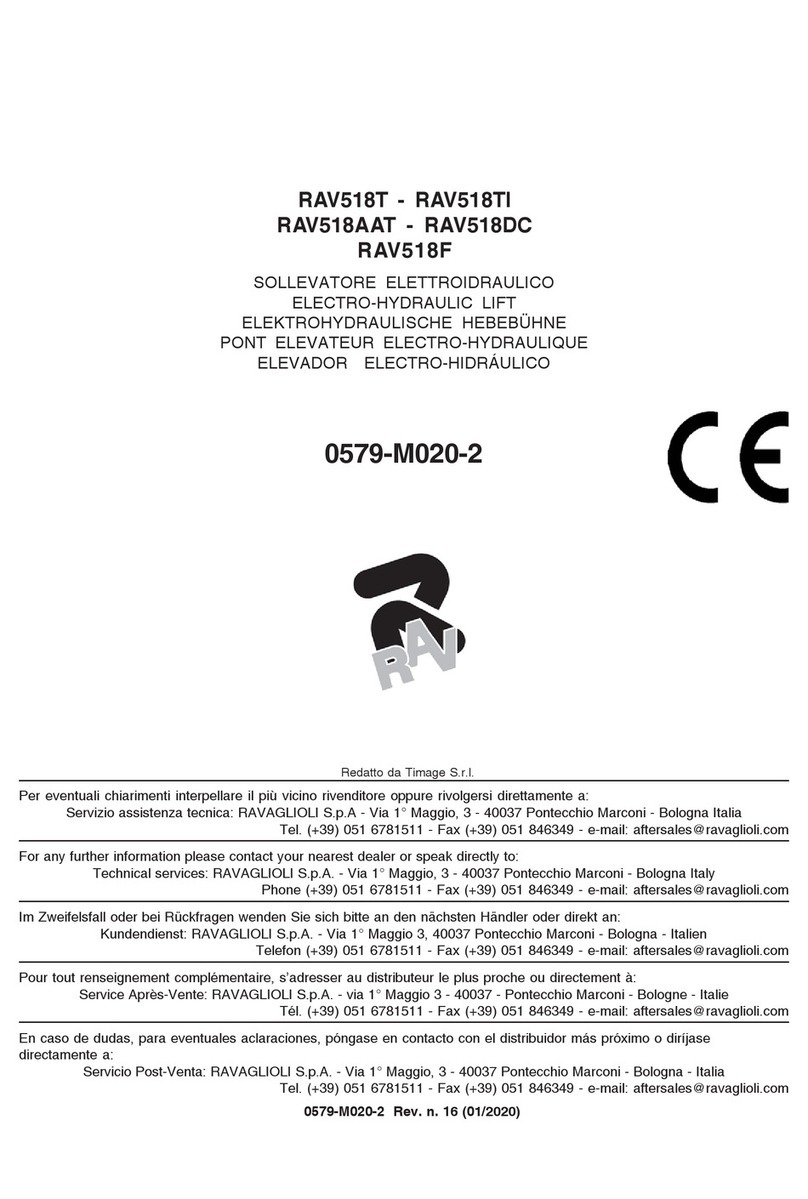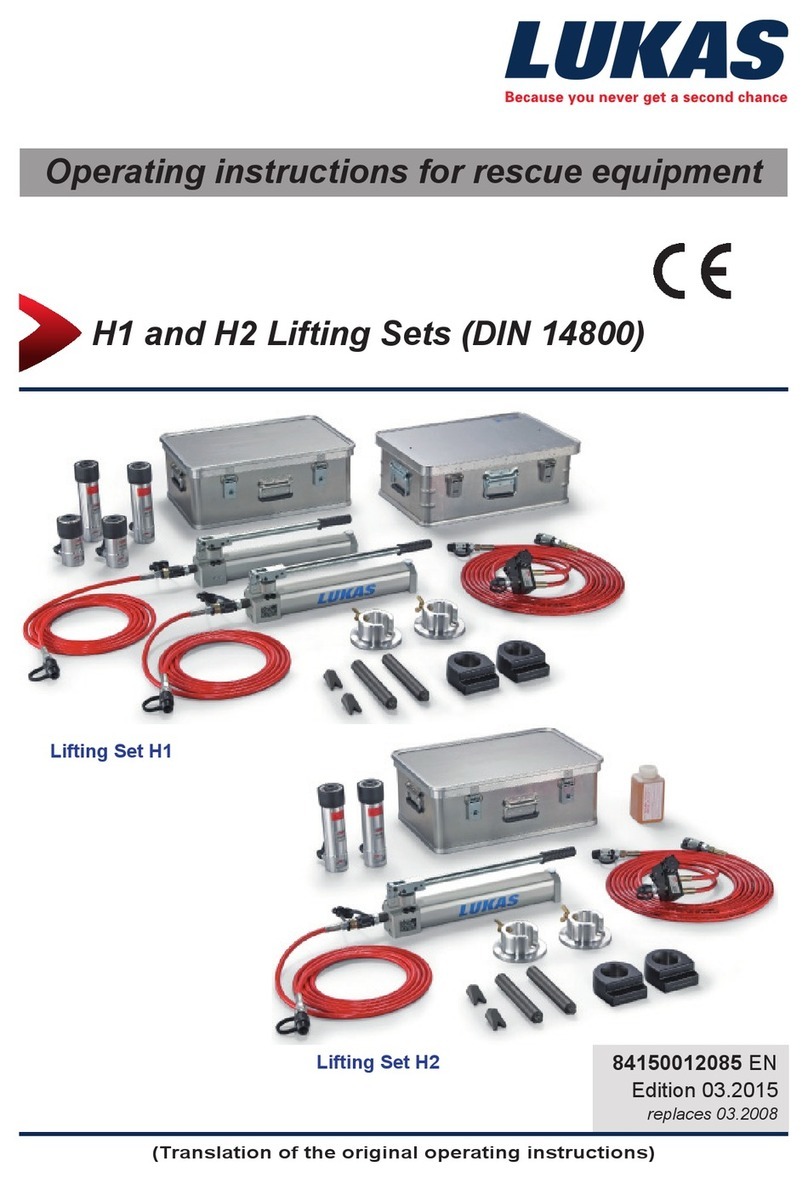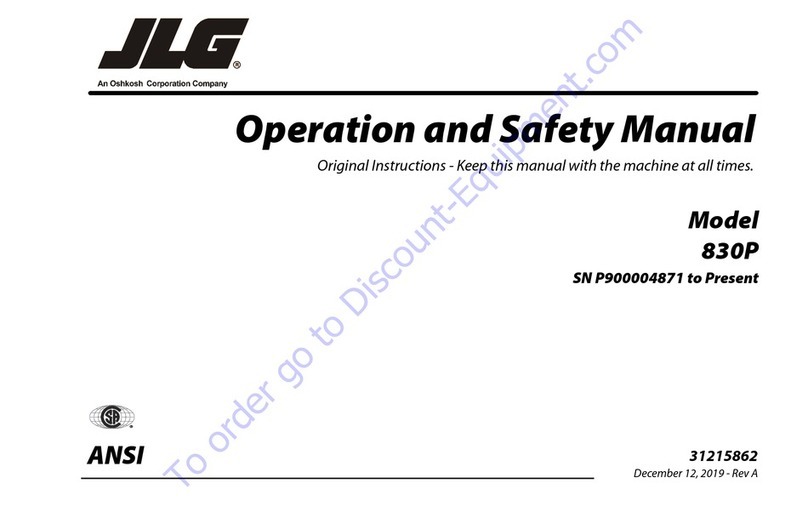Simpro Multi-Tip MT1200 User manual

User Manual // Simpro Multi-Tip®
Original Instructions // English // v83.0 // October 2022
USER MANUAL

Copyright © 2022 Simpro Handling Equipment Ltd.
No part of this document may be reproduced or transmitted in any form or by any means,
electronic, mechanical, photocopying, recording, or otherwise, without the written
permission of Simpro Handling Equipment Ltd.
For the purposes of standards compliance and international conformity, this document uses
Système International (SI) units. These may be converted to Imperial units as follows:
1 kilogram (kg) = 2.2 pounds (lb)
1 metre (m) = 1000 millimetres (mm) = 39.37 inches (in) = 3.28 feet (ft) = 1.09 yards (yd)
The following stylistic conventions are used throughout this document:
Point of interest
Safety hazard
§ Section reference (hyperlink in PDF edition)
Simpro partcode (hyperlink in PDF edition)

User Manual // Simpro Multi-Tip®
Original Instructions // English // v83.0 // October 2022 // Page 2

Contents
1. Product Overview ......................................................................................................................... 5
1.1 Key Features ........................................................................................................................................ 6
1.2 Construction ........................................................................................................................................ 6
1.3 Mechanism .......................................................................................................................................... 6
1.4 Safe Working Load .............................................................................................................................. 6
1.5 Duty cycle ............................................................................................................................................ 7
1.6 Service life ............................................................................................................................................ 7
1.7 Noise emissions .................................................................................................................................... 7
1.8 Environmental restrictions ................................................................................................................... 8
1.9 Ingress protection................................................................................................................................ 8
1.10 Notes..................................................................................................................................................... 8
2. Operating Instructions ..................................................................................................................9
2.1 Before operation ................................................................................................................................. 9
2.2 Emplacing and removing bins........................................................................................................... 9
2.2.1 Cradle identification........................................................................................................................................9
2.2.2 Type-E Cradle (standard) ..............................................................................................................................11
2.2.3 Type-C Cradle ................................................................................................................................................ 11
2.2.4 Type-A Cradle ................................................................................................................................................ 11
2.2.5 Type-A Cradle with base ..............................................................................................................................12
2.2.6 Type-D Cradle ................................................................................................................................................ 12
2.2.7 Type-X Cradle (custom)................................................................................................................................. 12
2.3 Operation of controls........................................................................................................................ 13
2.4 Battery charging................................................................................................................................ 14
2.5 Safety Norms...................................................................................................................................... 15
3. Care and Maintenance.............................................................................................................17
3.1 Quick Troubleshooting Guide .......................................................................................................... 17
3.2 Cleaning............................................................................................................................................. 18
3.3 Cradle jams........................................................................................................................................ 18
3.3.1 Cradle jams while raising............................................................................................................................... 18
3.3.2 Cradle jams while lowering ........................................................................................................................... 18
3.4 Electrical System (battery)................................................................................................................ 20
3.4.1 International conformance...........................................................................................................................20
3.4.2 Voltmeter ........................................................................................................................................................ 20
3.4.3 Batteries .......................................................................................................................................................... 20
3.4.4 Battery charger .............................................................................................................................................. 21
3.4.5 Charging lead ................................................................................................................................................ 21
3.4.6 Emergency stop .............................................................................................................................................21
3.4.7 Circuit breaker................................................................................................................................................ 21
3.4.8 Solar panel...................................................................................................................................................... 21
3.5 Electrical System (3-phase mains) ................................................................................................... 22
3.5.1 International conformance...........................................................................................................................22
3.5.2 Transformer .....................................................................................................................................................23

User Manual // Simpro Multi-Tip®
Original Instructions // English // v83.0 // October 2022 // Page 4
3.6 Electrical System (1-phase mains) ................................................................................................... 24
3.6.1 International conformance...........................................................................................................................24
3.6.2 Transformer .....................................................................................................................................................24
3.6.3 Variable Speed Drive..................................................................................................................................... 24
3.7 Hydraulic System ............................................................................................................................... 25
3.7.1 Powerpack ..................................................................................................................................................... 25
3.7.2 Control valves................................................................................................................................................. 25
3.7.3 Lift ram.............................................................................................................................................................25
3.7.4 Hydraulic fluid.................................................................................................................................................25
3.7.5 Maintenance.................................................................................................................................................. 25
3.7.6 Hydraulic system schematic.......................................................................................................................... 26
3.8 Preventative Maintenance Inspections.......................................................................................... 27
3.8.1 Pre-inspection checklist ................................................................................................................................. 27
3.8.2 Monthly inspection......................................................................................................................................... 27
3.8.3 Annual inspection .......................................................................................................................................... 29
4. Assembly, Handling and Storage.............................................................................................. 31
4.1 Assembly ............................................................................................................................................ 31
4.2 Moving................................................................................................................................................ 31
4.3 Lifting .................................................................................................................................................. 31
4.4 Transport............................................................................................................................................. 31
4.4.1 Horizontal transport ........................................................................................................................................32
4.5 Storage............................................................................................................................................... 32
5. Safety Assessment ....................................................................................................................... 33
5.1 Safety features................................................................................................................................... 33
5.2 Reasonably foreseeable misuse ...................................................................................................... 33
5.3 Hazard and Risk Assessment Guide................................................................................................. 33
5.4 OSH Compliance Specification Guide ........................................................................................... 38
6. Spare Parts ................................................................................................................................... 41
7. Warranty....................................................................................................................................... 43
8. EC Declaration of Conformity ................................................................................................... 45
9. Notes.............................................................................................................................................46

1. Product Overview
Congratulations on your purchase of a Simpro Multi-Tip. The Multi-Tip is everything a bin lifter
should be; safe, cost-effective, and easy to use. With a 150kg lifting capacity and 15-second
tipping cycle, it is an ideal solution for schools, recycling centres and small businesses.
Featuring an innovative monomast design, the Multi-Tip affords operators a clear view of
operations to ensure safety. No cage-guard is required, because the two-hand control
system prevents operators from accessing moving parts
while using the machine. The open design is also
simple to clean and maintain.
The standard Multi-Tip dumps bins at
1600mm, and is available with
cradles to suit almost all common
waste bins and carts. However,
the modular architecture makes it
simple to customise the machine
for non-standard applications
such as emptying BRUTE® bins,
205-litre drums, or fish bins at
heights of 1200mm, 1600mm or
1800mm.
Like all Simpro products, the Multi-Tip is safe, durable, and
requires little maintenance.
As far as compliance and relieving me of hard work, this is the best -
absolutely the best!
Graham Hawkes –Caretaker –One Tree Hill College

User Manual // Simpro Multi-Tip®
Original Instructions // English // v83.0 // October 2022 // Page 6
1.1 Key Features
Key features of the Multi-Tip include:
1. A unique tipping action whereby bins are lifted straight up, and then gently rolled
forward around the lip of the container being emptied into. Benefits of this design
in and high stability in use.
2. A large lifting capacity of 150kg.
3. A reliable, maintenance-free design.
4. Castor wheels and grab-handles for ease of movement.
5. A powder-coated frame and zinc-plated cradle for corrosion protection.
6. A modular cradle architecture which can be easily adapted to suit different bins, and
does not require clamping or fastening simply place the bin into the cradle and
1.2 Construction
The Multi-Tip consists of a steel frame with one vertical mast, a bin cradle, one hydraulic ram,
guarding, castor wheels, powerpack cover, grab handle with control buttons, power lead or
battery, hydraulic powerpack and control systems.
1.3 Mechanism
When operated, the bin cradle moves vertically in the masts, and is inverted at the
appropriate height by track. A hydraulic ram provides
the force to lift the bin. The ram is operated by a hydraulic powerpack, which is normally
powered by a battery. Electronic control systems allow the operator to raise or lower the bin
in a controlled manner.
1.4 Safe Working Load
The Safe Working Load of the standard Multi-Tip is 150kg (330lb).
Safe Working Load (SWL) is a gross figure, referring to the weight of the bin, its contents,
and any other objects placed on the cradle.
Custom machines may be specified with different Safe Working Loads. The rating plate
should be the first point of reference when determining SWL on any given machine.
Never attempt to lift bins that are heavier than the factory-specified Safe Working Load.

1.5 Duty cycle
The duty cycle of the Multi-Tip depends on the installed powerpack, available power supply,
environmental factors, and the manner in which the machine is being used. The figures given
below are indicative only.
Power supply
Duty Cycle (tipping ~100kg bins at 1600mm)
Net throughput
Number of bins
Units
24V/20Ah GEL Battery*
5,000kg
50 bins
Per charge
24V/20Ah GEL Battery on
continuous charge
2000kg
20 bins
Per hour
24V/40Ah GEL Battery with
Solar Panel Kit**
2,000kg
20 bins
Per day
Mains, 3-Phase ~415VAC
12,000kg
120 bins
Per hour
Mains, 1-Phase ~230VAC
6,000kg
60 bins
Per hour
12V/20Ah GEL Battery***
2,500kg
25 bins
Per charge
12V/55Ah GEL Battery***
6,000kg
60 bins
Per charge
*Two 12V/20Ah batteries in series (standard from 2022) **Subject to weather, latitude, and panel orientation (see §3.4.8) ***Discontinued 2022
Power supply
1.6 Service life
The nominal service life of the Multi-Tip is as follows.
Average Gross Bin Weight
Nominal service life
< 50kg
100,000 cycles
50kg –100kg
75,000 cycles
100kg –150kg
50,000 cycles
> 150kg
10,000 cycles
1.7 Noise emissions
The noise emissions of the Multi-Tip do not typically
Hearing protection is recommended if operating the machine for extended periods.
ISO standards for machinery safety specify that noise emissions are to be measured in A-
weighted decibels (dB(A)), a unit of volume which is adjusted to reflect the sensitivity of
human hearing. The measurements are taken at a point 1.6 metres above the ground at
s working position.

User Manual // Simpro Multi-Tip®
Original Instructions // English // v83.0 // October 2022 // Page 8
1.8 Environmental restrictions
The Multi-Tip may be used indoors or outdoors. However, the following restrictions apply:
1. A minimum floor area of two square metres, with a clear passage to exits;
2. Height above sea level not more than 1000m;
3. Ambient temperature not higher than +40℃and not lower than -10℃;
4. At ambient temperatures above 35℃, the relative humidity should not exceed 50%; at
lower temperatures, higher relative humidity is permitted;
Never operate the machine in explosive, corrosive, acidic or alkaline environments.
1.9 Ingress protection
Item
IP Rating
Push buttons, switches, and lamps
IP66
Door interlock
IP66
Coded magnetic switch
IP66
Motor
IP54 (note additional protection provided by covers)
Overall
IP54 (optional upgrade to IP66 or IP69K)
1.10 Notes
1. This User Manual describes approved procedures for the operation, maintenance,
and routine inspection of the Simpro Multi-Tip hydraulic bin-tipping machine.
2. This manual is written in English, and is to be conside
the purposes of EU Machinery Directive 2006/42/EC.
3. Operator(s) must read and understand this manual before using the machine.
4. If the machine is to be leased, sold, or otherwise transferred, then this manual shall
accompany the machine.
5. This is a generic manual. Simpro reserves the right to change the design of our
products at any time. In cases where a discrepancy exists between the manual and
the actual product, the manual is to be used as a reference only.
6. Contact your authorized Simpro agent if any problems or faults are encountered with
the machine.
7. Errors in this manual should be reported by email to info@simpro.world.

2.Operating Instructions
Before the machine is used for the first time, a site-specific Hazard and Risk Assessment
should be completed as per §5.3.
2.1 Before operation
Before operating a Multi-Tip, check that the machine is stable and safe to use as follows:
1. The machine is on firm ground with a slope ratio of less than 1:12.
2. All covers and safety guards are in place.
3. The wheel brakes are applied.
4. All personnel other than the operator are well clear of the machine.
5. The cradle is fully lowered.
6. The key is inserted and turned to the ON position.
7. The battery indicator (if fitted) shows an acceptable level of charge.
2.2 Emplacing and removing bins
The Multi-Tip cradle is designed to allow bins to be emplaced and removed easily, while also
holding them securely throughout the tipping cycle.
It is important to understand how to correctly place bins onto the cradle, as improper
placement may result in bins falling out of the machine when inverted.
2.2.1 Cradle identification
A range of different cradles may be fitted to the Multi-Tip, depending on the bins it will be
emptying. Use the following table to identify the correct instructions for your machine.
Cradle
Usage
Bin Compatibility
Cradle Image
See
Type-E
(EN840
base-lift
cradle)
Standard waste
and recycling
applications in EU,
UK, AU, NZ, Asia,
Africa, and parts of
South America
EN840 mobile
garbage bins
(wheelie bins)
-60L
-80L
-120L
-140L
-240L
§2.2.2
Type-C
(EN840
comb-lift
cradle)
Specialised waste
and recycling
applications
(primarily with 360-
litre bins) in EU, UK,
AU, NZ, Asia,
Africa, and parts of
South America
-60L
-80L
-120L
-140L
-240L
-360L
§2.2.3

User Manual // Simpro Multi-Tip®
Original Instructions // English // v83.0 // October 2022 // Page 10
Cradle
Usage
Bin Compatibility
Cradle Image
See
Type-A
(ANSI bar-
lift cradle)
Standard waste
and recycling
applications in
USA, Canada, and
parts of South
America
ANSI Z245.60
(Type-B) Trash
Carts
-32 gal
-48 gal
-64 gal
-96 gal
§2.2.4
Type-A
with base
(ANSI bar-
lift cradle
with base)
Specialised waste
and recycling
applications in
USA, Canada, and
parts of South
America
BRUTE® Bins
205L Drums
Plastic Tubs
Customs Bins
-10 gal
-20 gal
-28 gal
-32 gal
-40 gal
-44 gal
-55 gal
§2.2.5
Type-D
(DIN9797)
Food processing
applications
DIN9797
Eurobins
-120L
-200L
-300L
§2.2.6
Type-X
Custom
applications
BRUTE® Bins
205L Drums
Plastic Tubs
Customs Bins
§2.2.7

2.2.2 Type-E Cradle (standard)
2.2.2.1 Emplacing bins
Place the wheelie bin onto the cradle. For full-size 240L bins,
both wheels should be positioned into a catch (on either side of
the cradle). For smaller bins such as 60L, 80L, 120L and 140L, only
the left-hand wheel needs be positioned into a catch. Once
the bin is correctly emplaced, walk to the control panel.
The wheel catches are designed to work with standard
EN840 wheelie bins from leading brands such as Europlast, Sulo,
ESE, Weber, Craemer, OnePlastics and Trident.
Some smaller bin manufacturers use axles of different lengths. If the distance between
the wheels is slightly too large or small, the wheels may jam against the catches,
preventing a secure emplacement. Should this occur, simply unbolt and remove the
right-hand wheel catch. All bins can be securely retained using the left-hand catch only.
Some smaller bin manufacturers use tyres which are too wide to fit inside the wheel
catches. Should this issue occur, simply insert additional packers (flat washers) onto the
wheel catch mounting bolts, to increase the spacing as needed.
2.2.2.2 Removing bins
Using the grab-handle provided, gently remove the wheelie bin from the cradle.
2.2.3 Type-C Cradle
2.2.3.1 Emplacing bins
Place the wheelie bin into the machine, positioned centrally against
the cradle backplate. Take care that the lifting teeth are properly
hooked into the bin combing; smaller bins such as 60L and 80L may
need to be tilted or lifted sli
bin is correctly emplaced, walk to the control panel.
2.2.3.2 Removing bins
Using the grab-handle provided, gently remove the wheelie bin
from the cradle. Some bins may need to be tilted or lifted slightly to
detach them from the cradle teeth.
2.2.4 Type-A Cradle
2.2.4.1 Emplacing bins
Place the trash cart into the machine, positioned centrally against the
cradle backplate. Take care that the lifting hooks are properly
engaged with the front of the cart; some carts may need to be tilted or
lifted
emplaced, walk to the control panel.
2.2.4.2 Removing bins
Using the grab-handle provided, gently remove the trash cart from the
cradle. Some carts may need to be tilted or lifted slightly to detach
them from the lifting hook.

User Manual // Simpro Multi-Tip®
Original Instructions // English // v83.0 // October 2022 // Page 12
2.2.5 Type-A Cradle with base
2.2.5.1 Emplacing bins
Place the bin, drum, or container onto the cradle, positioned centrally
against the backplate. Once the bin is correctly emplaced, walk to
the control panel.
When moving heavy non-wheeled containers, it is
recommended to use a dolly, hand truck or forklift
attachment.
The catch arm(s) should be positioned to hold the top
edges of the bin, with a maximum free travel of 25mm (1
inch). The arm(s) can be unbolted and repositioned to
allow emptying bins of many different sizes.
2.2.5.2 Removing bins
Holding the upper lip of the bin, drum, or container, gently remove it from the cradle.
2.2.6 Type-D Cradle
2.2.6.1 Emplacing bins
Wheel the Eurobin into the cradle, positioned centrally, until it is
firmly against the buffers. Take care that both trunnions are
properly seated into the lifting arms; some Eurobins may need
to be tilted or lifted
the Eurobin is correctly emplaced, walk to the control panel.
2.2.6.2 Removing bins
Using the grab-handle provided, gently remove the Eurobin
from the cradle
2.2.7 Type-X Cradle (custom)
2.2.7.1 Emplacing bins
Place the bin, drum, or container onto the cradle, positioned
centrally against the backplate. Once the bin is correctly
emplaced, walk to the control panel.
When moving heavy non-wheeled containers, it is
recommended to use a dolly, hand truck or forklift
attachment.
The catch arm(s) should be positioned to hold the top edges
of the bin, with a maximum free travel of 25mm (1 inch). The
arm(s) can be unbolted and repositioned to allow emptying
bins of many different sizes.
2.2.7.2 Removing bins
Holding the upper lip of the bin, drum, or container, gently remove it from the cradle.

2.3 Operation of controls
The Multi-Tip controls are designed to allow safe, intuitive operation of the machine.
It is important to understand how to use the controls correctly. Improper operation may
result in a safety hazard, or damage to the machine.
1. Before operation, check that the machine is stable and safe to use as per §2.1.
2. Place the full bin on the cradle, taking care that it is correctly positioned as per §2.2.
3. Standing at the operator controls, visually confirm that no other person is within two
metres of the machine.
4. Simultaneously press and hold the SAFETY button under the left side of the shroud,
and the RAISE button under the right side. The cradle will start to lift.
5. When the cradle reaches the fully-raised position, the sound will change. Immediately
release the SAFETY and RAISE buttons, and wait for the bin to empty.
6. When emptying is complete, simultaneously press the SAFETY and LOWER buttons,
holding both down until the cradle rests back on the ground.
7. Remove the empty bin as per §2.2.
8. Repeat from step 2. as required.
Release the SAFETY button to stop the cradle at any time.
Do not continue pressing the RAISE and SAFETY buttons after the cradle has reached the
fully-raised position. This will drain the battery, and can overheat the hydraulic fluid.

User Manual // Simpro Multi-Tip®
Original Instructions // English // v83.0 // October 2022 // Page 14
2.4 Battery charging
The Multi-Tip batteries should be recharged whenever the voltmeter reads less than 24.0V.
To recharge the batteries, simply plug one end of an IEC C13 power lead
into the C14 socket on the machine, and the other end into a 1-phase mains power outlet.
A full charge usually takes around 5 hours. The machine can be used while charging.
The onboard charger automatically adapts to different inputs (85-264VAC 50/60Hz 1-ph),
manages the charging cycle to maximise battery life, and prevents overcharging.
The charger delivers enough power to empty a 100kg bin in about 3 minutes, which
means that a battery-powered Multi-Tip can be left plugged in and used as a mains-
powered machine (see §1.5).
For optimum battery life, the Multi-Tip should be placed on charge overnight and on
weekends, even if the batteries are already fully charged.
The charger is in an enclosed plastic case, and is protected against short-circuit, current
overload, over-voltage, and over-temperature.

2.5 Safety Norms
The following safety norms must be observed for the safe use of a Multi-Tip bin lifter.
Only trained and authorised personnel may use the
machine.
Operators must read and obey all instructions
displayed on the machine.
Never operate the machine on soft ground, or
ground with a slope ratio greater than 1:12.
Never operate the machine on the edge of a raised
loading dock or platform.
Never operate machine with any covers or guards
removed.
Never attempt to empty the contents of closed-top
drums, unless the machine is securely bolted down.
All persons other than the operator must keep at
least 2 metres clear while the machine is in use.
Always keep hands and feet well clear of the bin and
cradle when operating.
Never place limbs, feet or foreign objects under or
through the guarding panels.
Never attempt to empty over-filled bins, or bins
weighing more than 150kg.

User Manual // Simpro Multi-Tip®
Original Instructions // English // v83.0 // October 2022 // Page 16
Before connecting machine to mains supply,
ensure voltage and frequency correspond with
that listed on the rating plate.
Do not use an extension lead longer than 15
metres to connect the machine to mains power.
Do not operate if power lead, insulation or power
plugs are damaged.
Do not connect a damp power plug or socket.
Ensure the power supply socket is fitted with a
residual current device.
Ensure there is complete continuity between the
machine and an effective earthing system which
complies with local and national regulations. The
manufacturer cannot be held liable for the
consequences of an inadequate earthing system.

3.C are and Maintenance
The Multi-Tip is designed to give many years of service with minimal maintenance. In the
event a fault or malfunction does occur, refer to the Quick Troubleshooting Guide in §3.1
before contacting your Simpro agent for support.
Contact your Simpro agent if repair or service work is required.
All repair and service work must be carried out by qualified personnel.
Replacement parts must be supplied by Simpro or an authorized Simpro agent, and must
be of the same design and specification as the original parts.
A detailed Service Manual giving specific testing and repair instructions is available on
request from Simpro.
3.1 Quick Troubleshooting Guide
Please refer to the Quick Trouble Shooting Guide below before requesting technical support.
Problem
Possible Causes
Remedy
See also
The machine
will not lift
bins, and the
motor does
not run
Flat battery
The battery needs to be charged if
voltmeter reads less than 24.0V.
§2.4
Battery 0250050004
Tripped circuit
breaker or fuse
Wait 1-2 minutes for circuit breaker to
reset (or replace blown fuse). Avoid
operating machine with flat battery.
§3.4.7
Breaker 0790050374
Fuse 0790050107
Faulty up/down
switch or wiring
Check and rectify replace if
necessary.
Up/Down switch
0790050454
Faulty motor
solenoid (battery
models only)
The motor solenoid should click when
the UP and SAFETY buttons are pressed
if not it may need to be replaced.
24V Motor solenoid
0880050015
The machine
will not lift
bins,
although the
motor runs
Bin too heavy
Remove material from bin to reduce
the weight.
§1.4
§3.3.1.1
Pressure-relief
valve set too low
Contact your agent for instructions on
adjusting the pressure setting.
§3.7.2.2
3-phase motor
running in reverse
Swap two of the phase wires in the
power plug (3-phase machines only)
§3.5.1
Cradle will
not come
down from
the fully
raised
position
Mast sliding block
jamming in mast
Lightly lubricant inside of mast, slider
block and rollers with silicone spray
§3.3.2.2
Mast block
0090120001
Lift ram jamming
Contact your agent for support.
§3.3.2.2
MT1600 Ram
0230090001
Faulty up/down
switch, wiring, or
lowering valve
coil
DOWN and SAFETY buttons are
pressed if not, check the up/down
switch, wiring and lowering valve coil.
§3.3.2.1
Up/down switch
0790050454
24V Lowering valve
Coil 0250090067
Cradle
jamming
part-way
down
Mast bent or
damaged
Check and straighten replace if
necessary.
§3.3.2.2
Tipping guide flap
sticking or
damaged
Check and rectify replace if
necessary.
§3.3.2.2
Tipping guide flap
0230040001

User Manual // Simpro Multi-Tip®
Original Instructions // English // v83.0 // October 2022 // Page 18
3.2 Cleaning
The machine may be cleaned with a low-pressure water jet, a microfiber cloth, and a mild
cleaning solution. Cleaning should be carried out with the cradle in the fully-lowered position.
Do not clean the machine with a high-pressure water jet or waterblaster.
See §1.9 for IP ratings of the machine and major subcomponents.
3.3 Cradle jams
Occasionally the bin cradle may become jammed at some point in the tipping cycle. This is
usually a minor issue which can be easily rectified.
The cradle is not powered down it is lowered by gravity alone.
See §3.7.6 for a schematic diagram of the hydraulic system.
3.3.1 Cradle jams while raising
If the cradle jams while raising the cause may be either an overweight bin, or a mechanical
fault, such as a bent tipping guide or misaligned roller.
3.3.1.1 Overweight bin
1. Lower the cradle to ground level and remove the bin.
2. Remove some material from the bin, then try again.
If the pressure-relief valve is adjusted incorrectly, the cradle can stall even when lifting
bins that are within the Safe Working Load as per §1.4. The pressure-relief valve
may only be adjusted by a qualified technician, with prior authorisation from Simpro.
3.3.1.2 Mechanical fault
1. If possible, lower the cradle to ground level and remove the bin.
2. Attempt to visually identify the cause of the jamming. The most likely causes are:
a. The lifting chain may have derailed from the guide at the top of the mast.
b. The mast may have been bent or damaged.
c. Lack of lubrication on the follower roller , or the main cradle axle
d. The roller arm may be pressing against the tipping guide, due to the cradle
sitting out of level or being incorrectly adjusted.
3. With the cradle lowered, rectify the problem by straightening and/or realigning the
mechanical components as required. If the mast is bent, you may need to contact
your agent for support.
4. Run the machine through several full cycles to ensure the problem has been resolved.
3.3.2 Cradle jams while lowering
If the cradle jams on the way down, or has jammed on the way up but will not come down, it
may be due to a hydraulic, electrical, or mechanical fault.
0090120000

3.3.2.1 Hydraulic or electrical fault
When the SAFETY and LOWER buttons are pressed simultaneously, the lowering valve should
e problem may be either a hydraulic or
electrical fault.
1. Manually remove the bin if it is safe to do so.
2. Use a forklift or hoist to physically support the cradle in position.
Never place any part of your body underneath the cradle unless it is securely supported.
3. Remove the powerpack cover.
4. Check that the lowering valve coil is receiving an electrical signal. An LED
lamp should glow on the coil plug when the SAFETY and LOWER buttons are pressed
simultaneously. If it does not, check the up/down switch and wiring.
5. If the coil is receiving an electrical signal but not opening, it may need to be cleaned:
a. Remove the coil from the valve stem.
b. Unscrew the lowering valve cartridge.
c. Clean the cartridge with compressed air.
d. Replace the lowering valve components by reversing this procedure.
6. Detach the forklift/hoist from the cradle, and test to see if the cradle lowers correctly.
7. Run the machine through several full cycles to ensure the problem has been properly
resolved. If the lowering valve is still not operating correctly, it may need to be
replaced contact your agent.
3.3.2.2 Mechanical fault
If the l
buttons are pressed), the problem may be a mechanical fault.
1. Manually remove the bin if it is safe to do so.
2. Use a forklift or hoist to physically support the cradle in position.
Never place any part of your body underneath the cradle unless it is securely supported.
3. Attempt to visually identify the cause of the jamming. The most likely causes are:
a. The lifting chain may have derailed from the guide at the top of the mast.
b. The mast may have been bent or damaged.
c. Lack of lubrication on the follower roller, or the main cradle axle
d. The roller arm may be pressing against the tipping guide, due to the cradle
sitting out of level or being incorrectly adjusted.
4. Rectify the problem by straightening and/or realigning the mechanical components
as required. If the mast is bent, you may need to contact your agent for support.
5. Detach the forklift/hoist from the cradle, and test to see if the cradle lowers correctly.
6. Run the machine through several full cycles to ensure the problem has been resolved.
0250090067
0250090055
This manual suits for next models
2
Table of contents
Other Simpro Lifting System manuals
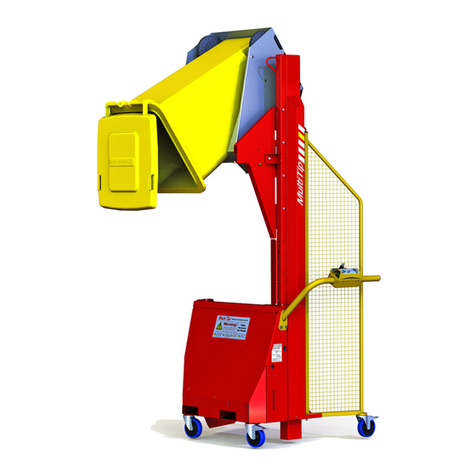
Simpro
Simpro Multi-Tip User manual
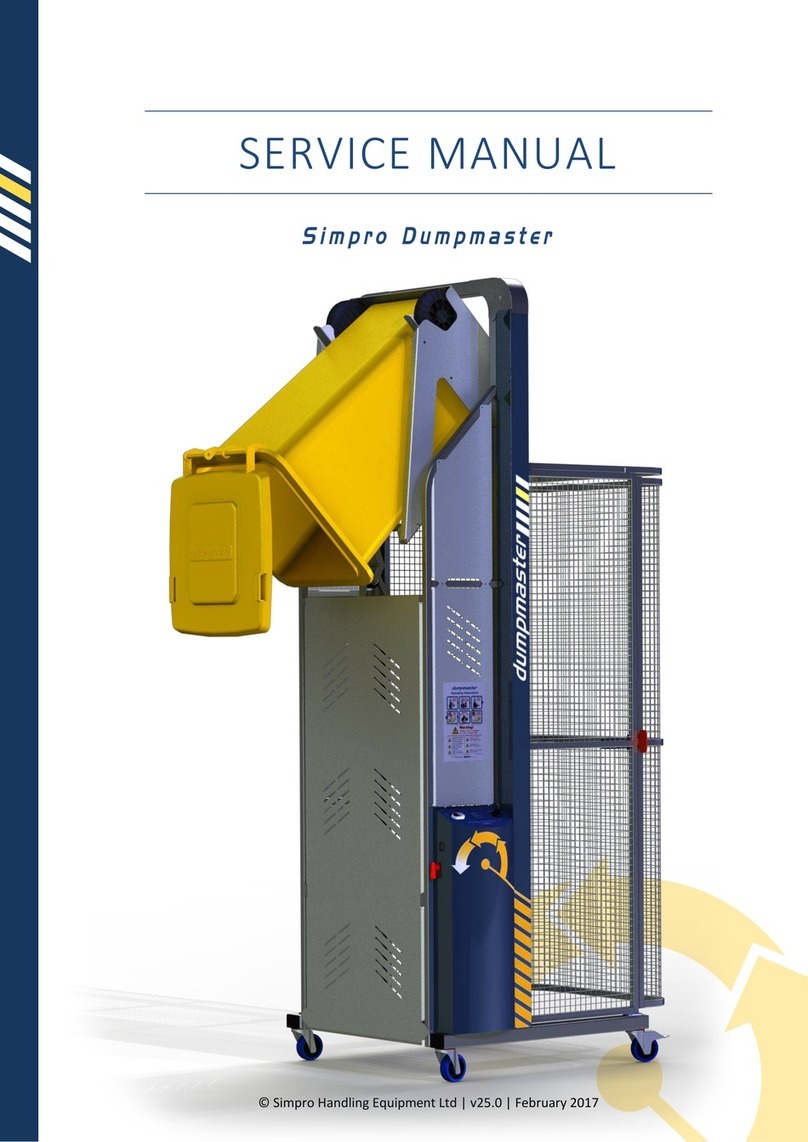
Simpro
Simpro Dumpmaster User manual
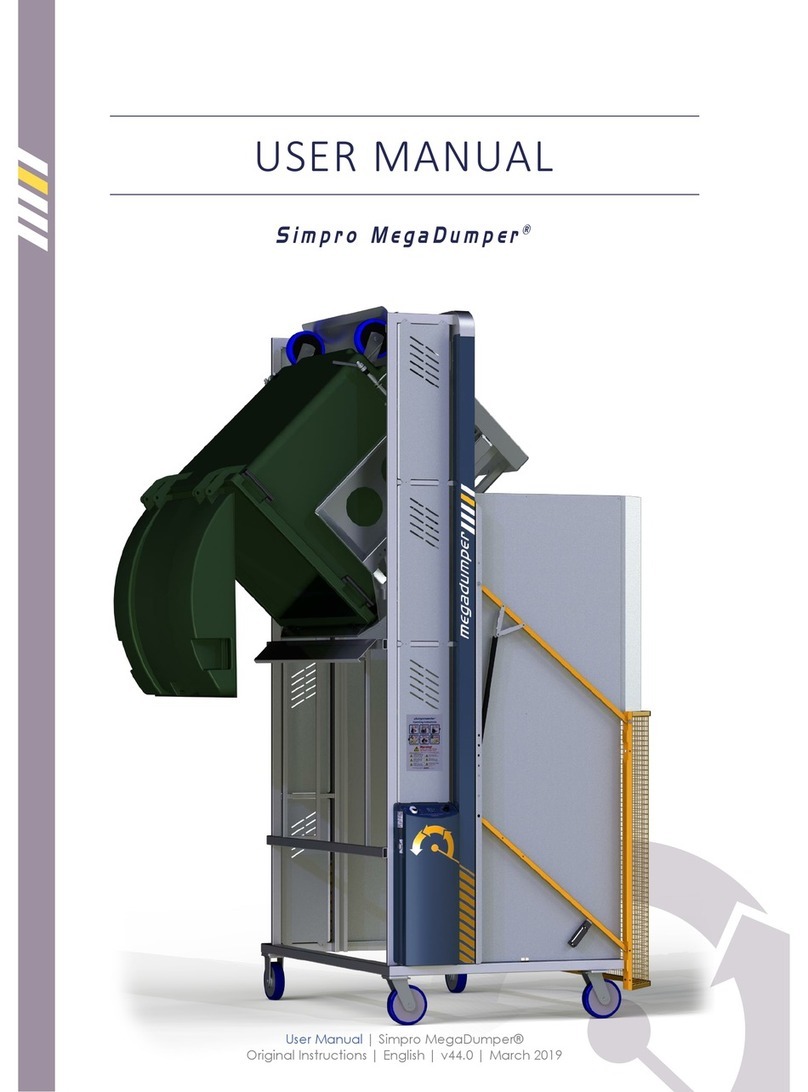
Simpro
Simpro MegaDumper User manual
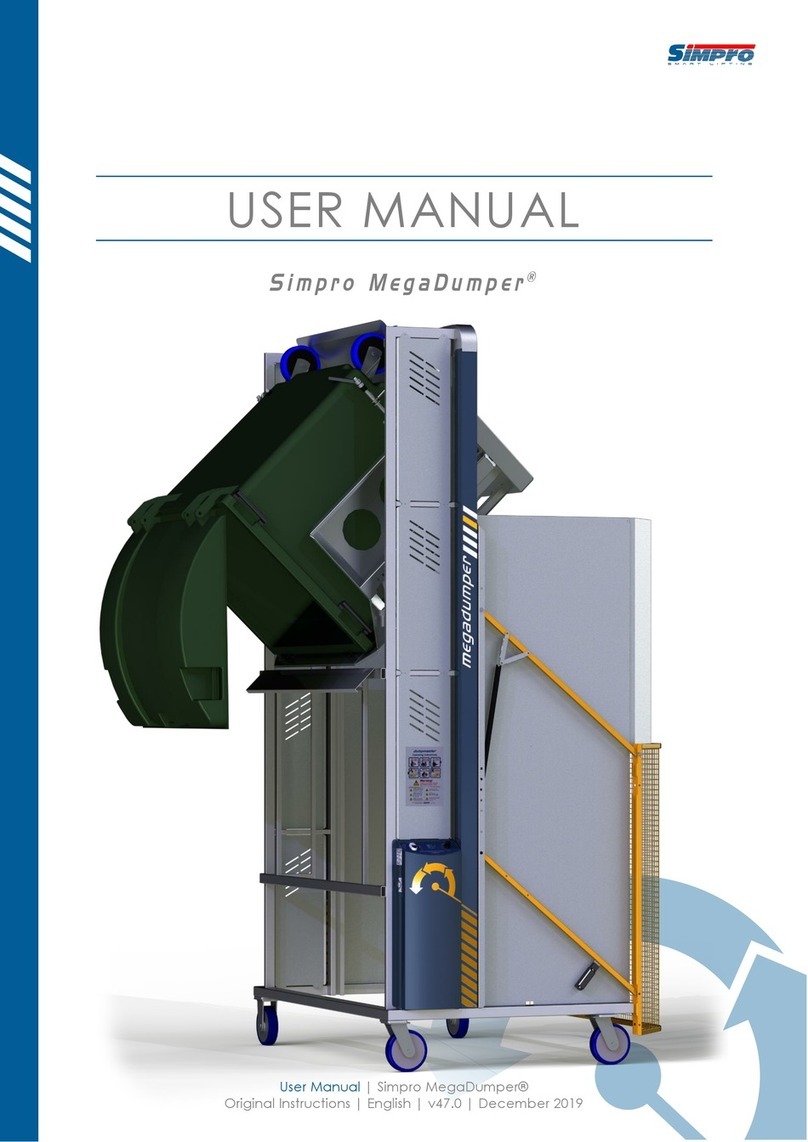
Simpro
Simpro MegaDumper Series User manual

Simpro
Simpro QUIKSTAK QS10MM User manual
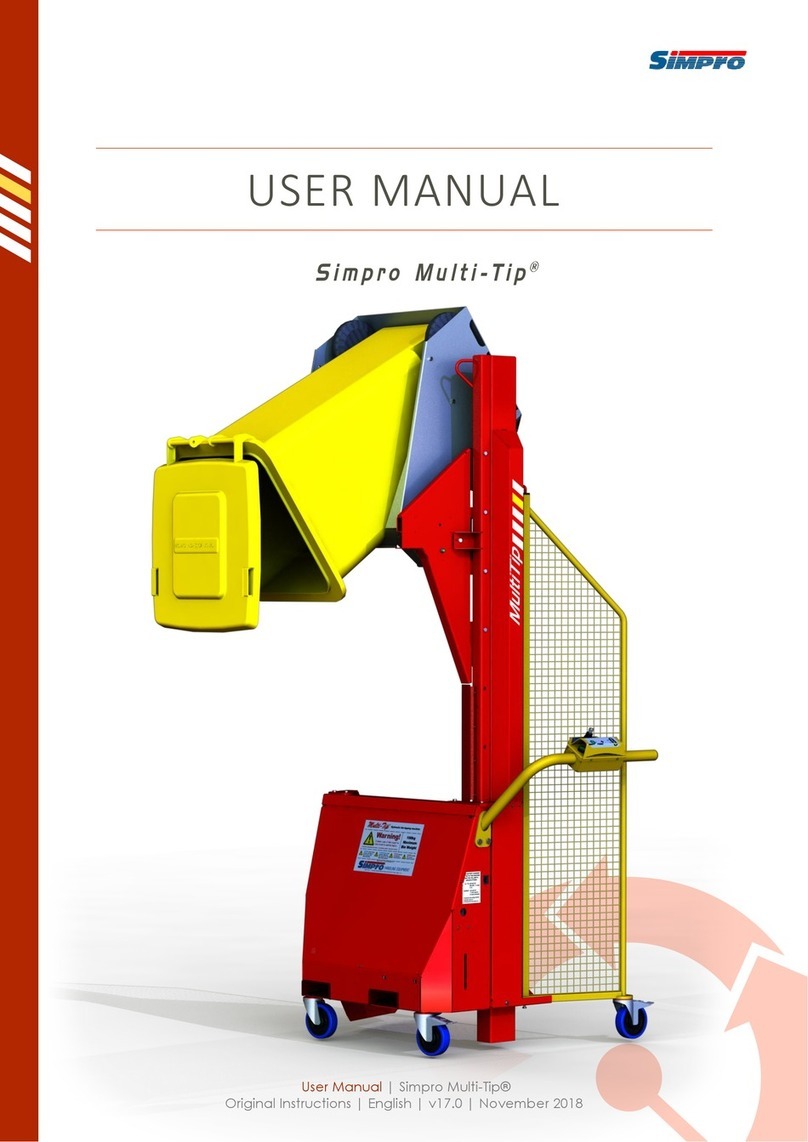
Simpro
Simpro Multi-Tip User manual
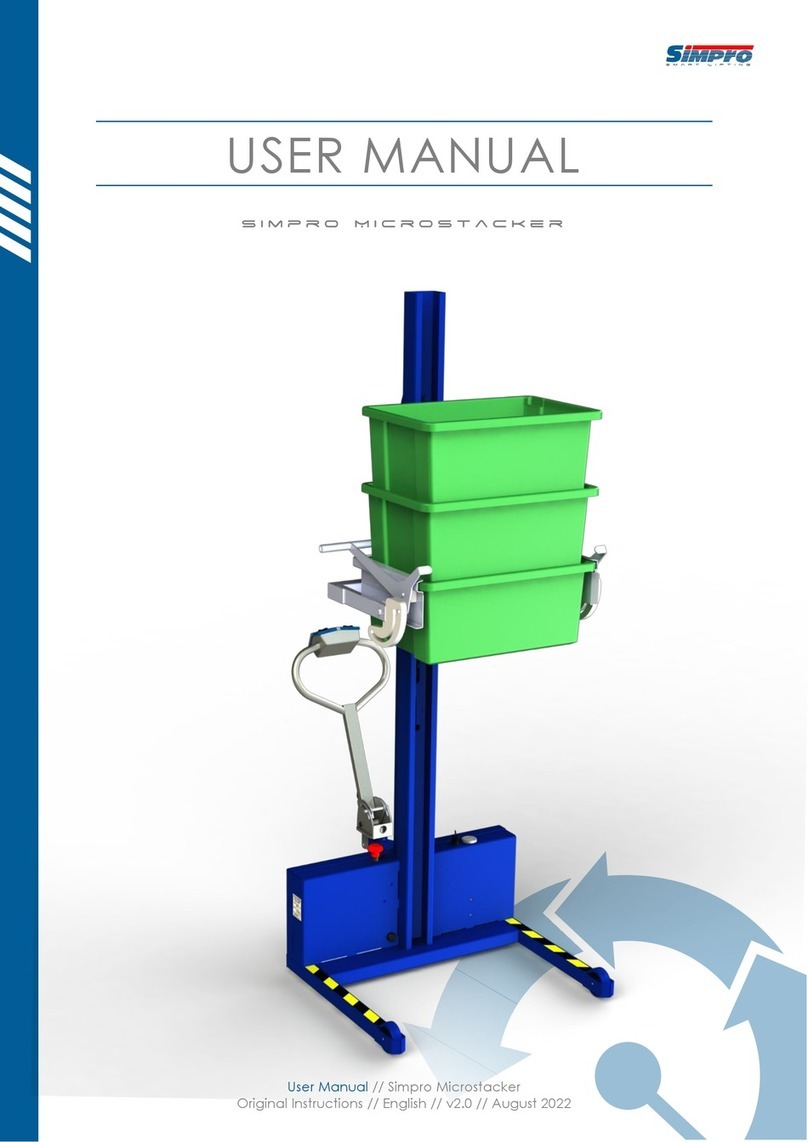
Simpro
Simpro Microstacker User manual

Simpro
Simpro EUROVER User manual
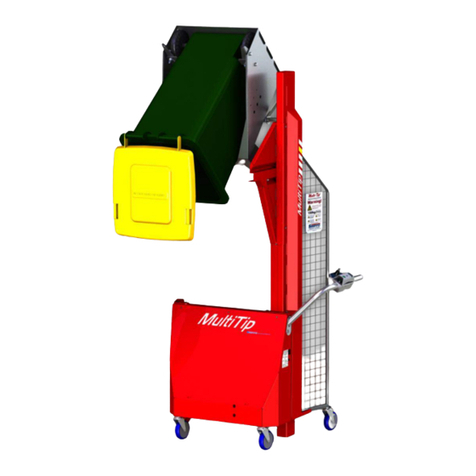
Simpro
Simpro Multi-Tip 1600 User manual
Popular Lifting System manuals by other brands
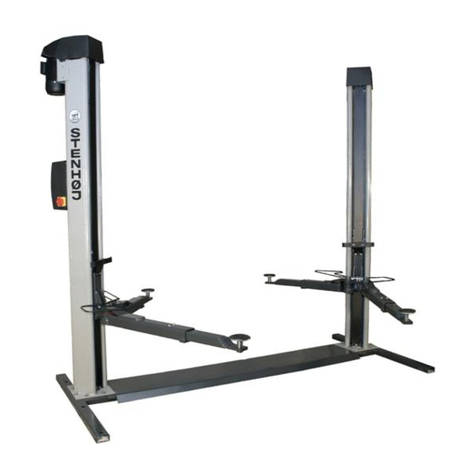
Stenhoj
Stenhoj MASCOT 1.25 Operation and maintenance instructions

morse
morse 400A-96SS-125 Operator's manual

JLG
JLG LIFTLUX 210-25 Operation and safety manual

Titan Lifts
Titan Lifts HD2P-10000AC-D Installation, operation & maintenance manual

morse
morse 195A-A Operator's manual
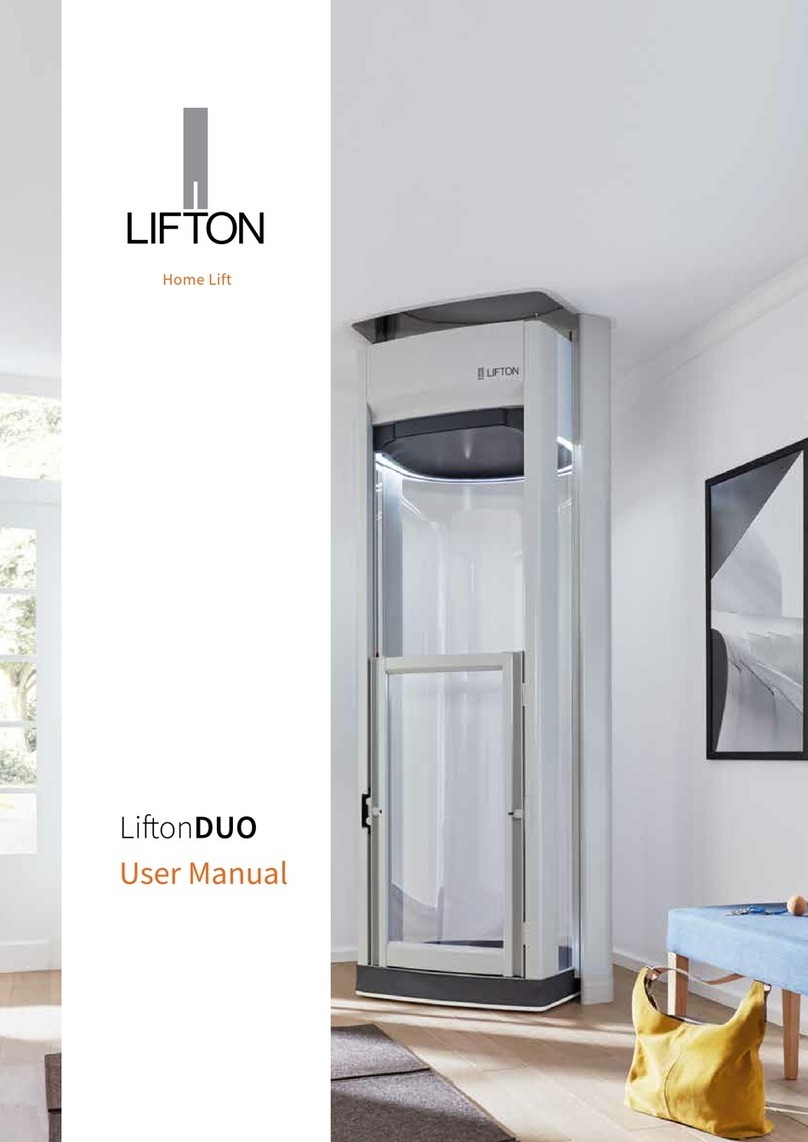
Lifton
Lifton DUO user manual
